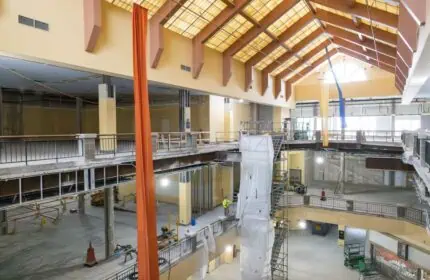Media
Clean up continues on Fox River floor in Green Bay
Release Date: 05/22/2016 | The Green Bay Press Gazette
GREEN BAY–Maybe you’ve noticed it recently: the Mark Anthony quietly working its way along the river in the downtown Green Bay area.
It’s a slow process, with the dredge seemingly just sitting there in the water, when in fact it’s been taking up contaminated dirt from the river bottom by the tons–4.5 million cubic yards of it so far–as it inches along, cleaning about two acres of river bottom every day and a half.
The dredge has been in the water during boating season every year since 2009, but this year is the first time Green Bay residents would have seen it so close to home. It’s a sign that its work is nearing completion.
After this, there’s just one more season of one of the largest PCB remediation projects the world has ever seen, right here in the greater Green Bay area.
“I don’t know if it’s the largest,” said Beth Olson, project manager for the Wisconsin Department of Natural Resources. “I suppose it depends on how you measure it, the length of the river, the pounds of sediment–We could be. I haven’t fact-checked that.”
The project deadline of 2017 was set years ago and cleanup contractors still hope to meet it, although Olson has her doubts.
“We may likely have additional work to do in 2018, she said. “We’ll do the main dredging, test it, then residual dredging, test some more and then there’s confirmation testing before we can say the river is done.”
But whether it’s 2017 or 2018, it’s a good news story for the greater Green Bay community, Olson said.
“This is one of the hardest-working rivers in the country and we’re cleaning it up collaboratively–and it’s unprecedented. We have corporations working with government to make it happen and we’re almost done,” she said. “These last few miles are the part of the river that the downtown area gets to enjoy.”
Boldt Technical Services, a division of The Boldt Company, which is overseeing the entire production for the DNR and the U.S. Environmental Protection Agency, invited the Green Bay Press-Gazette along on a tour of the cleanup process this week.
Polychlorinated biphenyls, or PCBs, aren’t unique to the Green Bay area, but the preponderance of paper mills in the area brought the Fox River, from Neenah to Green Bay, under federal scrutiny as concerns grew in the 1970s over the health hazards posed by the chemical.
PCBs were used in all kinds of industrial processes, but here they were used in NCR Corp.’s production of carbonless copy paper and then further spread into the ecosystem by the pulp recycling process as area paper companies bought NCR’s scrap and used it to add fiber to their recycled paper products.
NCR and the other area paper companies are still battling in federal court over how to divide the costs of the project, expected to be near $1billion before it’s all over. The wheels of justice likely will still be turning long after the Mark Anthony and its little brothers, the dredges Ashtabula and Ottawa River, have scooped up the last of the contaminants and moved off to some other environmental disaster.
Vacuum and clean
“The large dredge is like a big vacuum cleaner,” says Jay Grosskopf of Boldt. “We use the smaller ones to clean up around the edges, in the shallow water where he can’t get.”
The dredging is only the first stage of the process. The rest of it happens at the Green Bay Processing Facility, a multi-million- dollar factory that sprang up in the early 2000s in the middle of brownfield at 1611 State St, across the river from Jimmy Seas. This is the temporary headquarters of J.F. Brennan, the company whose boats are dredging the river bottom, Tetra Tech, which is the lead contractor for the project and Boskalis Dolman, which owns and operates the high-tech gear that separates the water from the solids dredged up.
Brennan’s dredges are no less high-tech and state-of-the-art. The flagship Mark Anthony, in particular, is an amazing bit of technology. It has two hydraulically operated poles in front that stand up like giant goalposts, but descend to the river bottom to hold the boat in place when needed. It has a pole in back, too, that pushes the boat when the two poles in front lift, so that the boat scuttles clam-like along the river bottom as it dredges.
Also in front is a 45-foot arm, the end of which carries a massive boring tool, called the cutter head that loosens up the river bottom. Immediately behind it is a pipe that sucks in everything the cutter head loosened up.
“Not many dredges have this system,” said Matt Dorow, Brennan’s project engineer.
The dredged material is pumped along a long movable pipeline, a 10-inch plastic pipe with inch-and-a-half thick walls. Tugs are used to keep that pipe from drifting. Once the pipe fills with dredge material, it sinks out of the way of boaters, but it’ll float to the surface whenever dredging and pumping stops. It’s why area boaters need to be mindful of the buoys.
The Mark Anthony pumps the dredge material along the pipeline, with auxiliary pumps helping it along the way.
“Depending on the type of sediment, it’s going on average about eight or nine feet per second through the pipeline,” Dorow said.
The process has carried the muck as far as 10 miles, but on this particular day, it’s going only about a mile, all below the surface, so the dredge material — and the PCBs — never see the light of day. When the sludge enters the processing plant, it goes immediately through the scalping screen, which works as a giant sieve, vibrating and shaking out everything except stuff bigger than six centimeters.
“It gets a lot of beer bottles,” Grosskopf said.
The bigger stuff is trucked to a landfill. The remaining sludge passes to increasingly finer screening processes, taking out more and more of the solids. The screening process is fine enough to extract sand particles as small as 43 microns — about the size of fine beach sand. PCBs don’t adhere well to those, so concentrations are low enough to allow beneficial re-use for that sand, like to fill in road construction projects, so it doesn’t need to be landfilled.
The finest particles filtered out of the water are dried in spinners as thoroughly as possible. They are then put between large plates that squeeze out the last bit of water and crushed into “filter cakes” that are carted off to huge piles in a storage building. Those filter cakes are the end result of the material dredged from the river only five hours earlier.
From the storage building, they are trucked to one of two special landfills, depending on the remaining toxicity level, Olson said. None of the levels are extremely high, because the contaminated sediment is diluted with clean sediment, but both landfills, one near Whitelaw and the other near Chilton, are built with clay liners for protection and are highly regulated. Brennan has a fleet of 24 trucks that haul 22 tons of filter cakes per trip and five trips a day to the landfills.
As the sediment is dried in spinning machines, the extracted water is collected, filtered as clean as possible and then piped to the facility’s water treatment plant.
The treatment plant isn’t much different from that of any municipal water treatment plant, Grosskopf said. He claims the treated water is clean enough to drink, although Olson demurred, saying the water is at least as clean as industrial discharge standards require.
In any case, it’s piped back into the Fox, right behind the processing facility. From dredge to discharge, the water process takes about eight hours.


